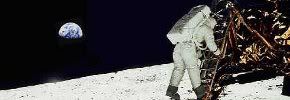A reason out of the professionals why Ares was scrapped. Doubtless, though, armchair directors will continue to say it would've been fine.President Barack Obama's 2011 federal budget proposal, released today, scraps NASA's latest plan to return humans to the moon by 2020. The budget plan looks to turn the agency's attention to developing new engines, in-space fuel depots and robots that can venture out into space.
"This is a very exciting new direction for NASA," said NASA's Chief Financial Officer Beth Robinson during a press conference this afternoon. "We'll be providing tremendous benefit to future space explorers."
NASA administrator Charles Bolden explained that the Obama administration plan calls for cancelling the Constellation moon landing plan that was initiated by former President George W. Bush.
The Constellation program was behind schedule, and was projected to ultimately be over budget, he added. Officials feared that Constellation program would sap funding and attention from developing new technologies, and financially force NASA to withdraw its support for the International Space Station as soon as 2015.
The new mission, along with a five-year budget plan, calls for the space station to continue operating and conduct new scientific experiments at least through 2020. And instead of building new crafts that could take humans further into space, the new plan calls for NASA to work with commercial aeronautics companies to design and build new so-celled space taxis that could take astronauts to the space station and eventually into outer space.
"I think this is a significant vote of confidence in NASA and an exciting shift," said Sally Ride, a former NASA astronaut and a member of the presidential panel charged with assessing the future of U.S. manned space flight. "The committee concluded that the current trajectory is not sustainable. The [space station] was going to be sacrificed after 2015 to fund the Constellation program. Science had suffered. This strategic shift brings NASA back to its roots. It's a significant strategic investment."
Ride added that she's confident that the Obama plan is a much better path for NASA - and a path that will lead to greater space exploration, not less.
"This puts NASA on sure footing," she said. "NASA will be central to the innovation engine that will drive America's economy in the future. It ensures that as we explore the solar system, we will do it with new technologies and we will do it arm-in-arm with commercial and international partners."
The budget would provide that space agency with $7.8 billion to spend over the next five years to develop new approaches to space flight, new rendezvous technologies and in-space fuel depots, according to Bolden. Another $3.1 billion would fund research into new propellants and heavy-lift engines designed to take astronauts farther and faster into space.
Bolden also noted that $4.9 billion would be invested in early stage technologies related to communications, sensors and robots.
Robinson added during the press conference today that over the next five years, $3 billion will be spent on robotics alone. She said they're focusing on preparing for robotic precursor missions. That means NASA is planning to land robots on the moon, for example, so they can gather information and send back data and video in advance of future human space missions.
"As you know, NASA already has had tremendous successes in its robotic endeavors," said Robinson. "The robots on the space station. The rovers on Mars. Those are science. These are meant to pave the way for human missions. That's their main purpose."
NASA also noted today that the plan to send robots into space could vey well increase the number of launches out of the Kennedy Space Center in Florida.
In interest for myself is a dedicated program for Robotic missions to prep and plan for human ones.
 Commander of the MFS Darwinian Selection Method (sexual)
Commander of the MFS Darwinian Selection Method (sexual)


 "
"